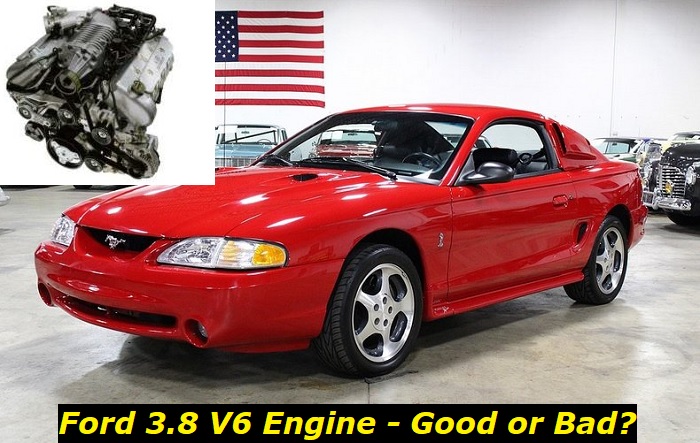The Ford 3.8 V6 is a lightweight naturally aspirated engine that was first manufactured by Ford Motor Company about 40 years ago.
Since then, it has been used in the majority of automobiles and light pickup trucks. Its small size and strong power attributes were crucial to its success.
Ford engines, on the other hand, are a terrific alternative if you don't require a ton of power and merely want a dependable and economical engine. With careful maintenance, they have been known to exceed 300,000 miles without major problems.
In this article, we are going to simply explain all you need to know about the Ford 3.8 V6 engine, with a particular emphasis on the methods in which you can make it last longer; without further ado, let's get started!

Key features and my opinion about the engine
- Production years:1982-2003
- Average lifespan of 3.8L V6 Essex:280,000-320,000 miles
- Fuel supply type:carburetor, later -port injection
- Power range:120-190 hp
- Fuel efficiency:bad
- Engine block material:cast-iron
- Engine reliability score:high
- The most common problems:a lot of possible leaks, vibrations, insanely low power.
Details about the Ford 3.8 Essex V6 Engine
The Ford 3.8L V6 engine has six cylinders that are aligned longitudinally, and both cylinder banks are angled at a right angle to one another. Acceleration is a crucial characteristic of the Ford engine that shows how fast the engine reacts and produces power when you push the accelerator, and it was utilized in millions of Ford automobiles between 1978 and 2003.
In addition, the engine displacement of the 3.8-liter V6 is somewhere between 232 and 233 cubic inches. The size of its cylinder bore ranges from 3.8 to 3.82 inches. Another essential parameter is the length of the piston stroke, which ranges from 3.78 to 3.8 inches. Its initial iteration features an output power range of 110-115 horsepower and a torque range of 170-180 pound-feet.
Based on the original design, Ford used die-casting to make the engine's blocks, heads, and other parts out of aluminum to make the engine lighter overall. However, to reduce their expenses, they turned to use cast iron blocks. However, the cylinder heads of every 3.8-liter V6 engine are made of aluminum.
Gasoline is used as the fuel source for the Ford 3.8L V6, and early versions of the engine include a carburetor system for spraying fuel into the cylinders. However, engines manufactured from 1984 were equipped with a fuel injection system, which improved the peak power and torque rating. Additionally, a multi-port fuel injection system was added, which increased the horsepower rating to 135-145 and the torque rating to 210-220 lb-ft.
On the other hand, each of its six cylinders is equipped with two valves. In contrast to the most modern single or double overhead camshaft (SOHC or DOHC) designs, this one utilizes the more time-honored overhead valve (OHV) configuration.
The use of lightweight aluminum components in the construction of the Ford 3.8L V6 engine contributes to the vehicle's excellent fuel efficiency. It was also intended to be small and economical in terms of fuel consumption so that it could be used in passenger cars like the Mustang, Granada, Mercury Capri, and Windstar.
How Reliable Is the Ford 3.8 V6 Engine
The Ford 3.8 V6 engine is quite reliable, but much like the engines in other cars, it has certain shortcomings of its own. In addition, the power rating may range anywhere from 110 to 230 horsepower, depending on the version and any modifications that are purchased.
It utilizes a dual port induction technology, which not only improves its fuel efficiency but also its output power as well as its torque. The most common complaint from current and former owners is that it tends to have frequent head gasket failure.
The engine is capable of 300,000-plus mile range and this is really a lot comparing with any modern engine of the same size.
Most Common Problem with the Ford 3.8 V6 Engine
The Ford 3.8L Essex V6 is a reliable engine that delivers excellent performance and runs efficiently. Despite this, consumers have reported experiencing the head gasket failure issue regularly throughout its lifetime of operation.
Additionally, the most common symptoms are white smoke from the exhaust pipe, inability to start, overheating, and misfiring. When the problem is serious, it may cause cracks in the engine head or block as a consequence of high temperatures brought on by a coolant leak from the seal. This can also cause the catalytic converter to get damaged.
The problem is mostly because the engine head and block are made of two different materials. As a result of this, they expand in various ways owing to the differing temperature pressures, which causes the gasket to get stressed and damaged. To remove its components, manual labor must be performed for many hours.
The recommended fix is to replace the head gaskets that are broken. It is recommended that you get in touch with Ford customer support to inquire about the availability of replacement components. In addition, get in touch with the dealership and car technician near you to get specific guidance on how to carry out this maintenance.
Ways to Make the Ford 3.8l V6 Last Longer
In this section, we'll speak about at least three ways to make the engine in your Ford car last longer. So, let's get started.
- Regular Oil Changes
It doesn't matter how good the Ford 3.8L V6 could be; if the oil and other fluids in it aren't replaced regularly, the engine won't live very long. The oil in vehicles of older models must be changed around every 3,000 miles, but the oil in vehicles of more recent models may go closer to 7,500 miles before requiring a change. Consult your user manual for oil-changing instructions.
- Maintain Tire Pressure
Tires are often overlooked, which causes them to wear out to the point where they blow out and need replacement. Not only is this reckless, but driving with inappropriate tire pressure has a major impact on both the performance and the engine of your vehicle, and it may even cause problems with the engine.
- Don't Continue Driving using Reserve Gasoline
The sediments that form at the base of your Ford 3.8L V6 engine tank are a result of the presence of sediments in gasoline. After years of use, there is almost certainly going to be a coating of filth that must not make its way to the engine. Running on low gasoline drags all of this debris into the fuel pump, which may cause a significant amount of wear on the pump.
Filling up your tank will save you money on the expense of repairing or replacing the gasoline filter and the fuel pump, so don't simply cross your fingers and hope it doesn't get to the engine.
Other Tips to Make Your Engine Last Longer
Inspect air filter regularly and don't forget to replace it when needed. Check the amount of engine coolant in your vehicle and add more if it's low. Last but not least, be sure you clean your spark plugs from time to time. Your Ford 3.8L V6 engine will be able to go longer between visits to the mechanic if you perform these simple maintenance procedures.
Conclusion
The Ford 3.8 V6 engine is reliable, although it is susceptible to a few typical issues. Changing the oil and filters regularly, using a better grade fuel, and avoiding excessive idling are all strategies to increase its longevity.
We hope this article helped you comprehend some of the most prevalent Ford 3.8 Essex V6 engine issues. Although there are no simple answers, there are steps that may be taken to prolong its life.
About the authors
The CarAraC research team is composed of seasoned auto mechanics and automotive industry professionals, including individuals with advanced degrees and certifications in their field. Our team members boast prestigious credentials, reflecting their extensive knowledge and skills. These qualifications include: IMI: Institute of the Motor Industry, ASE-Certified Master Automobile Technicians; Coventry University, Graduate of MA in Automotive Journalism; Politecnico di Torino, Italy, MS Automotive Engineering; Ss. Cyril and Methodius University in Skopje, Mechanical University in Skopje; TOC Automotive College; DHA Suffa University, Department of Mechanical Engineering






Add comment